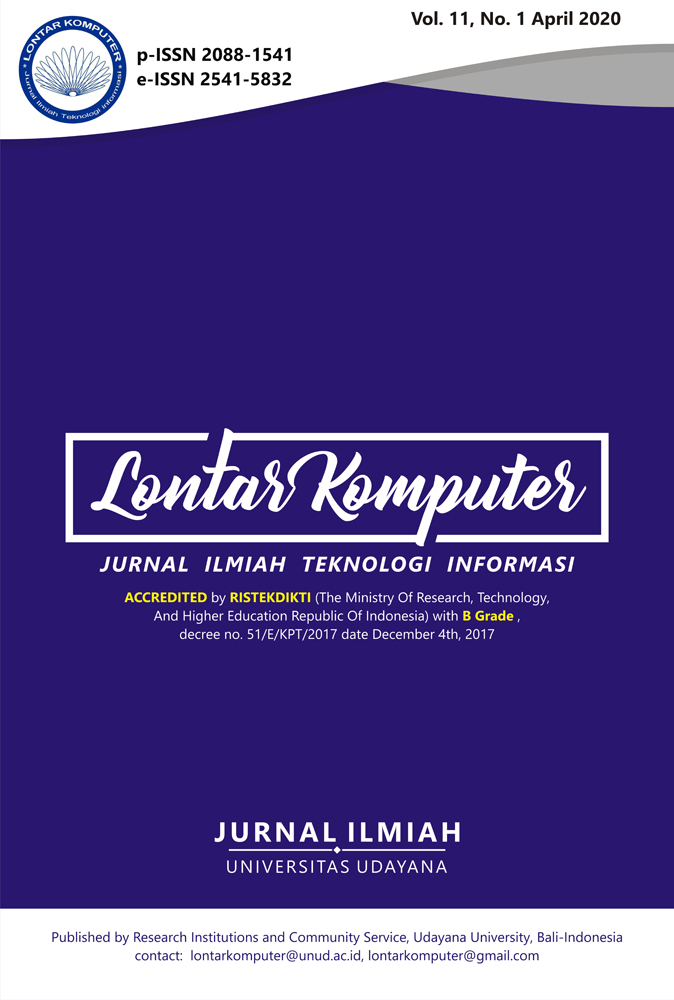OpenMP Performance in Numerical Simulation of Dambreak Problem Using Shallow Water Equations
Abstract
Numerical simulation of water surface waves is widely used to describe water flow and its impact for human life. For instance, numerical simulation of waves is elaborated to simulate Tsunami as an early warning system. Using numerical approach, the study of water flow will reduce cost and save time compared with the conventional approach (in laboratory). Shallow water equations (SWE) is one of the mathematical models which can be used to describe water flow. In numerical simulation of SWE, finite volume method is a robust method to approximate SWE. The result using numerical approach depends on the number of grids. High number of grids then smooth solution can be obtained. However, increasing number of grids leads to the increasing of computational cost. In this paper, parallel computing using OpenMP platform is given in order to reduce computational cost of numerical simulation. In parallel computing performances, Speedup and
Efficiency of numerical simulation using 6400 grids points are obtained 4 times and 51% respectively.
Moreover, by several numbers of cores from 2 to 8, CPU time of parallel computing is shown decreasing along the increasing number of computer cores.
Downloads
References
[2] B. Cushman-Roisin and J.-M. Beckers, Introduction to geophysical fluid dynamics: physical and numerical aspects. Academic Press, 2011, vol. 101.
[3] O. Delestre and P.-Y. Lagrée, “A well-balanced finite volume scheme for blood flow simulation,” International Journal for Numerical Methods in Fluids, vol. 72, no. 2, pp. 177–205, 2013.
[4] O. Delestre, S. Cordier, F. James, and F. Darboux, “Simulation of rain-water overland-flow,” in 12th International Conference on Hyperbolic Problems, vol. 67. American Mathematical Society, 2008, pp. 537–546.
[5] O. Delestre and F. Marche, “A numerical scheme for a viscous shallow water model with friction,” Journal of Scientific Computing, vol. 48, no. 1-3, pp. 41–51, 2011.
[6] E. Audusse, F. Bouchut, M.-O. Bristeau, R. Klein, and B. Perthame, “A fast and stable wellbalanced scheme with hydrostatic reconstruction for shallow water flows,” SIAM Journal on Scientific Computing, vol. 25, no. 6, pp. 2050–2065, 2004.
[7] F. Bouchut, Nonlinear stability of finite Volume Methods for hyperbolic conservation laws: And Well-Balanced schemes for sources. Frontiers in Mathematics. Birkhäuser Verlag, Basel, 2004.
[8] D. Doyen and P. H. Gunawan, “An explicit staggered finite volume scheme for the shallow water equations,” in Finite Volumes for Complex Applications VII-Methods and Theoretical Aspects. Springer, 2014, pp. 227–235.
[9] P. H. Gunawan, “Scientific parallel computing for 1d heat diffusion problem based on openmp,” in Information and Communication Technology (ICoICT), 2016 4th International Conference on. IEEE, 2016, pp. 1–5.
[10] M. de la Asunción, M. Castro, J. Mantas, and S. Ortega, “Numerical simulation of tsunamis generated by landslides on multiple gpus,” Advances in Engineering Software, vol. 99, pp. 59–72, 2016.
[11] M. De La Asunción, J. M. Mantas, and M. J. Castro, “Simulation of one-layer shallow water systems on multicore and cuda architectures,” The Journal of Supercomputing, vol. 58, no. 2, pp. 206–214, 2011.
[12] A. R. Brodtkorb, M. L. Sætra, and M. Altinakar, “Efficient shallow water simulations on gpus: Implementation, visualization, verification, and validation,” Computers & Fluids, vol. 55, pp.1–12, 2012.
[13] D. Castillo, A. Ferreiro, J. A. García-Rodríguez, and C. Vázquez, “Numerical methods to solve pde models for pricing business companies in different regimes and implementation in gpus,” Applied Mathematics and Computation, vol. 219, no. 24, pp. 11 233–11 257, 2013.
[14] R. J. LeVeque, Finite volume methods for hyperbolic problems. Cambridge university press, 2002, vol. 31.
[15] E. F. Toro, Riemann solvers and numerical methods for fluid dynamics: a practical introduction. Springer Science & Business Media, 2013.
[16] O. Delestre, C. Lucas, P.-A. Ksinant, F. Darboux, C. Laguerre, T.-N. Vo, F. James, S. Cordier et al., “Swashes: a compilation of shallow water analytic solutions for hydraulic and environmental studies,” International Journal for Numerical Methods in Fluids, vol. 72, no. 3, pp.269–300, 2013.
The Authors submitting a manuscript do so on the understanding that if accepted for publication, the copyright of the article shall be assigned to Jurnal Lontar Komputer as the publisher of the journal. Copyright encompasses exclusive rights to reproduce and deliver the article in all forms and media, as well as translations. The reproduction of any part of this journal (printed or online) will be allowed only with written permission from Jurnal Lontar Komputer. The Editorial Board of Jurnal Lontar Komputer makes every effort to ensure that no wrong or misleading data, opinions, or statements be published in the journal.
 This work is licensed under a Creative Commons Attribution 4.0 International License.
This work is licensed under a Creative Commons Attribution 4.0 International License.























